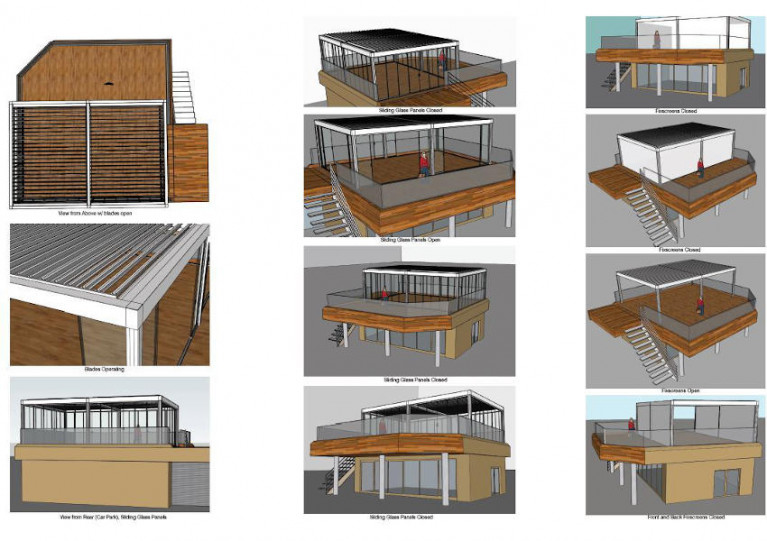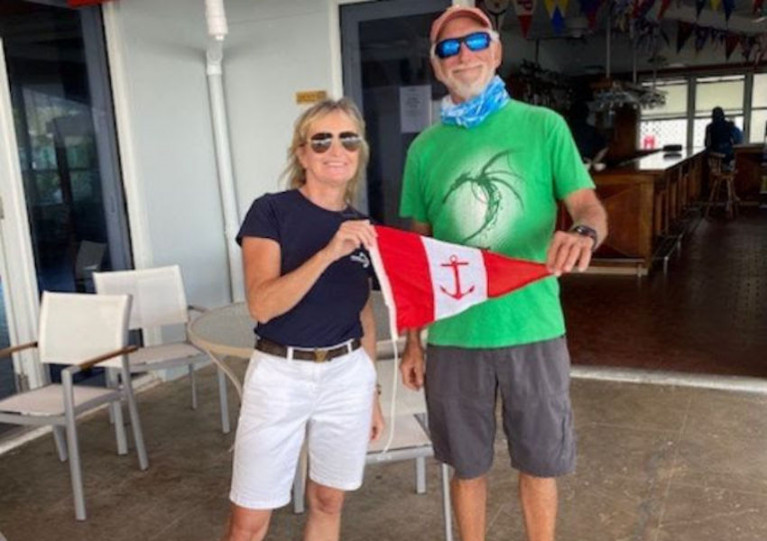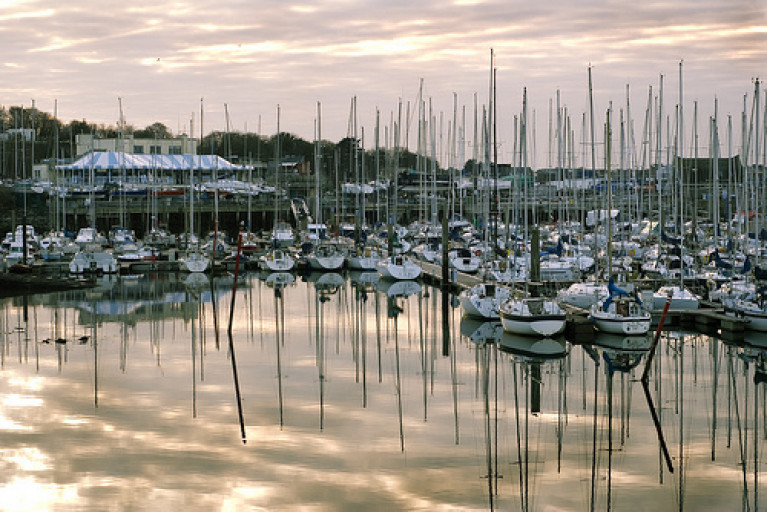Displaying items by tag: HYC
Fly the Flag for Ukraine in Howth Yacht Club Appeal
Howth Yacht Club offers so many ways to make your support for Ukraine go further.
The North Co Dublin club is matching donations through its crisis appeal for MSF on GoFundMe up to €5,000.
In addition, every euro of ever purchase of a flag or pennant (€15 for a small, €25 for a large) goes to the Irish Red Cross Ukraine Crisis appeal.
There are less than 25 flags left to purchase, so stop by the office this Easter weekend to get one before they’re gone.
Howth Yacht Club welcomes Cormac Farrelly to the clubhouse tomorrow evening (Thursday 7 April) to regale with tales from the tropics.
And the bar will be mixing Caribbean-inspired cocktails for the perfect accompaniment to the evening thats bound to inspire future cruising to — or chartering in — the West Indies.
Entrance is free for the talk which kicks off at 7.30pm — email [email protected] for more.
Howth Yacht Club Launches Crew Sailing Saturday Sessions
Next month, Howth Yacht Club will host the Crew Sailing Saturday Sessions, a three-session refresher course designed to get you back in sailing condition before the summer season kicks off.
Whether you’re in search of a crew or just want to shake off the cobwebs after a long winter, our keen keelboat instructors will get you in ship-shape before the official start of the season.
The sessions mean time on the water with club J-80 keelboats, and a chance to sharpen your skills with a fully qualified instructor.
Courses are designed in-house by Saoirse White, a Howth Yacht Club member who regularly races on Howth 17s, Puppeteers and cruisers.
There will also be a meet-and-greet with class captains in a reserved area of The Lighthouse, HYC’s new pergola, after each session to connect with savvy sailors or find a like-minded crew.
Each session runs from 9.30am to 1.30pm starting Saturday 2 April, with the second and third sessions on 9 and 23 April respectively. The cost is only €125 per member for all three sessions.
For more information and to book your spot, visit the Quest Howth website HERE.
Howth Yacht Club Hosting RS Aero Demo Day and Pre-Season Sailing Sessions
Howth Yacht Club has announced that three RS Aero rigs will be available to demo in the harbour on Sunday 27 March.
The demonstrations will run from 11am to 2pm on the day. Email the organiser Daragh Sheridan for more information, or to book your slot.
HYC is also offering practice sessions for the first three Saturdays in April leading up to the season launch on Tuesday 26 April. Those interested are invited to email Quest directly for more.
Other upcoming events in Howth, as outlined in Commodore Paddy Judge’s latest update, include the Student Yachting Nationals on the weekend of 26-27 March, the return of the Brassed Off event for dinghies on Good Friday and a Spring Warmers keelboat event in April. See the HYC website for more HERE.
Clockwise or Anti-Clockwise? The Choice Is in Sailors’ Hands as Howth’s Round the Island Race Returns
On Saturday 12 March, ask yourself whether going clockwise or anti-clockwise around Ireland’s Eye will bring you glory — as the Round the Island Race returns after a two-year break.
Supported by Key Capital, sponsors of Howth Yacht Club’s Winter Dinghy Series, the Round the Island Race (not to be confused with the Isle of Wight equivalent) traditionally marks the end of the Frostbite series which, as the offspring of the appearance of the revolutionary Laser dinghy in the 1970s, has now been running for nearly 50 years.
This year’s RTIR will be different, however. In addition to racing for the renamed ILCAs, the RS Aeros will join the fun and other dinghies wanting to get involved can race using the Portsmouth Yardstick (PY) handicap system.
The RS Aero is a modern lightweight single-handed dinghy with a growing fleet based in Howth and they expect to be joined by several visiting class-mates to enjoy the unique experience of racing around an island.
Interest has also been expressed by owners of an RS 800, RS 600, several RS Fevas, 420s and a 470. Boats that have been racing all winter in Dun Laoghaire Harbour and at the other Frostbite venues around the country are particularly welcome to take on the challenge.
Anyone sailing a dinghy, single- or double-handed, with a PY rating and a similar performance to the ILCAs and Aeros is invited to enter for a great day of racing and socialising as the RTIR makes its comeback after a two-year absence.
The winning ILCA usually completes the race in less than an hour and its skipper is the one who has sailed best and successfully resolved the clockwise/anti-clockwise riddle for the day.
Ireland’s Eye is a triangular shape with high ground towards one corner and the tides around it vary in strength and direction depending on time and location. The vagaries of wind and tide have seen many an early leader struggling to salvage a top-10 result – snakes and ladders afloat!
Dinghies already entered for the HYC Frostbite Spring Series get free entry to the event and those who have not can enter online.
The plan for the day is a 9.30am briefing ashore at the HYC race office, a warm-up race (warning signal 10.55am) over a course laid in Howth Sound to get proceedings afloat under way, and then the main event: the expedition around Ireland’s Eye.
The start and finish lines for the RTIR will be in Howth Sound and, between crossing them, the island must be left to port or starboard at each competitor’s discretion.
Lunch and the prize-giving for both the Frostbite Series and RTIR are an option after racing and, to round out a sporting day, the TVs in the clubhouse will show England taking on Ireland in Six Nations rugby at 4.45pm.
Howth Yacht Club’s Eve McMahon took the silver medal at the EurILCA Laser Radial Youth Championships in Croatia yesterday, Saturday 3 July.
The result from Kaštela, near Split, comes hot on the heels of her U19 silver medal at the ILCA European Championships in Montenegro last month.
Final scores have fellow Irish team member and Dingle Sailing Club’s Ellie Cunnane in 27th.
Among the boys, Jonathan O’Shaughnessy and Michael Crosbie of the Royal Cork Yacht Club finished in 26th and 33rd respectively in the Gold fleet.
Howth Yacht Club Commodore Paddy Judge has thanked members for their patience and support ahead of the return to racing and outdoor dining — as well as welcoming visiting Irish-based boats from elsewhere in Ireland — next Monday 7 June.
“It is a great relief to finally see the gradual return to a semblance of normality,” he said, adding that tables can now be reserved online.
The 20% bar discount for full members is being retained and all members have received a 10% subscription rebate on their cards for bar purchases.
Meanwhile, the marina team and volunteers have been busy getting the club ready for a wider reopening.
Committee boats are now refitted, marks are laid, the starter’s hut is on the East Pier and 25 new marina berths have been allocated this year “as evidence of a significant response to our new membership drive”.
The relaxing of COVID-19 restrictions last month allowed limited crews to sail and some have already started race training.
Howth’s Cruising Group have had their first armada to Lambay ahead of the scheduled race next Saturday 12 June, with one crew reportedly encountering so much weed “they could not maintain sufficient speed and had to abandon the cruise!”
Lambay bound
The Lambay Races mark the first major event of this year’s HYC calendar, and provision is being made for 100 socially distanced outdoor table spaces set out in three areas around the club after racing, allocated on a first come, first seated basis.
The new HYC food truck will be serving food on the main deck (adjacent to the marina walkway) during the day and those who wish to dine (or drink) at the club on the night of the races can book an outdoor table for after 7pm.
Crew registration is limited to HYC members and is online only. The club’s J80s will be available for charter by members for the Lambay Races.
Meanwhile, a number of HYC boats sailed their first ISORA and summer junior courses are fully booked in further signs that things are getting back to normal.
Club racing returns
Club keelboat racing recommences next Tuesday 8 June for one-designs and on Wednesday 9 June for the cruiser classes. Apart from the Howth 17s, who will use the East Pier hut line, racing will be from Starpoint and crews are advised to allow enough time for the extra distance to the start area north of Ireland’s Eye.
Dinghy racing will commence on Thursday 10 June in Howth Sound with See Wych being used as Committee Vessel. Entry forms, sailing instructions and course information can all be downloaded from the HYC website, and crew registration is online.
The club also has a new motor-boating group starting up, with plans for destination shore breaks to Skerries, Dun Laoghaire, Greystones and the Liffey — contact Alan Kinsella for more information — as well as three dinghy sailing groups running on Saturdays for all ages and all levels.
Marina notes
HYC members are advised that the club has encountered a fault with the large crane which the service company cannot determine. It will remain in use until the end of June with added safety measure, after which it will be taken out of service for approximately three weeks for a comprehensive overhaul.
In addition, supply chain and production issues have delayed delivery of the balcony pergola, which is now scheduled for late September. The repair to the balcony roof, which is leaking into the marina office, has it turn been delayed to September also.
Other changes afoot are in the administration of the club’s operations, and a Strategy Group is set to produce a report for the General Committee and members shortly.
And Commodore Judge commanded new club manager Aideen Doran who has “had a baptism of fire” in the role but has made progress in team building despite the prevailing restrictions and in reducing overheads, among other tasks.
“We want to increase the value of our club to members and hope all members will benefit from the current initiatives under way,” he said, adding: “I would encourage you to come to the club and enjoy some well-deserved fun.”
Future of Outdoor Dining at Howth Yacht Club is Warm & Dry With New Pergola Due This Summer
Howth Yacht Club has announced that regardless of the weather, members can look forward to warm and dry outdoor dining at the clubhouse this summer.
Funding has been secured and the order placed for a pergola with glass sliding walls, which the club says will add a new dimension to the balcony area for outdoor dining and all-weather access.
There is a lead time of up to 14 weeks for the order but it is hoped the new pergola will be installed by July. In the meantime, the balcony decking will be replaced over the next two months.
Phased return to the water
In other HYC news, the club is preparing for a phased return to the water later this month as children of school-going age may resume training from 26 April, while people from two households may sail on the same boat from the same date.
Competitions however remain prohibited and changing rooms are closed. And members are reminded that leisure sailing is only available to those for whom the club is within 20km from home if not in Co Dublin.
No racing is on the summer schedule until the Lambay Races on the June Bank Holiday weekend and the Optimist Leinsters on 12-13 June, restrictions allowing.
Vice Commodore Neil Murphy said it is also proposed to reactivate summer dinghy racing this year with two races every Thursday night.
A handicap class will provide the opportunity for the owners of the various types of dinghy in the club — including RS Aeros, RS400s and RS800s, International 14s and ISOs and — to bag bragging rights, while one-design starts will be provided for Optimists and Laser/ILCAs.
A six-week series will start the season, first race to be scheduled as soon as competitive sailing is allowed to recommence.
Old Lasers
The club also has plans to bring back its adult dinghy coaching and racing series, and is on the lookout for any old Lasers that members may have spotted in their localities, in order to add to its existing fleet. Get in touch with Neil Murphy or contact the HYC office if you have any suggestions or can help.
Howth Yacht Club Member Hands Over Burgee In Virgin Islands as Family’s Passage West Continues
Howth Yacht Club member Aisling Hassell has relayed a message back home after she and her family recently reached the Virgin Islands on their passage west.
While there, Aisling also took the opportunity to hand over the HYC burgee to Dave Franzel at St Thomas Yacht Club. Dave previously owned the Boston Sailing Centre where Aisling worked for two summers.
Aisling reports that Dave is running a very successful sailing school in the US Virgin Islands, which has led to a great increase in the number of members participating.
Readers can follow Aisling and her family as they continue their epic journey on Instagram @ohanasvoyage.
Howth Yacht Club Commodore’s Update Reveals Plans Ready for Sailing Restart
In the latest Commodore’s Update from Howth Yacht Club, Paddy Judge outlines its plans for a hopeful restart to sailing if restrictions allow from April.
Among the changes being considered are the purchase of more paddle boards and kayaks for members’ use, as well as more flexible coaching sessions and extra opportunities to get afloat on the club’s fleet of dinghies and J80s.
On the marina and clubhouse side, planning permission is being sought for a retractable awning to facilitate more outdoor dining.
And comments are being sought on the move to commission a strategy group to examine what changes will be required to best position the club over the next five to 10 years in terms of attracting new and younger members and increasing the value of membership.
For more, see the Commodore’s Update for February 2021 on the HYC website HERE.































































